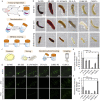Dec-DISCO: decolorization DISCO clearing for seeing through the biological architectures of heme-rich organs
- PMID: 34692197
- PMCID: PMC8515970
- DOI: 10.1364/BOE.431397
Dec-DISCO: decolorization DISCO clearing for seeing through the biological architectures of heme-rich organs
Abstract
The tissue optical clearing technique plays an important role in three-dimensional (3D) visualization of large tissues. As a typical solvent-based clearing method, 3DISCO can achieve the highest level of tissue transparency with favorable clearing speed. However, 3DISCO cannot deal with the residual blood within tissues, leading to tissue brownness or redness after clearing, thus greatly influencing the tissue transparency and image quality due to the strong absorption of residual blood. To address this problem, we proposed an optimized clearing method by introducing CUBIC-L solution combined with 3DISCO for effective decolorization, termed Dec-DISCO (Decolorization DISCO). Dec-DISCO achieves better transparency than 3DISCO for various heme-rich tissues and performs enhanced fluorescence preservation capability. Dec-DISCO allows high-quality 3D imaging of fluorescently labeled heme-rich organs, as well as pathological tissue with severe hemorrhage. Dec-DISCO is expected to provide a powerful tool for histological analysis of kinds of heme-rich tissues in various medical conditions.
© 2021 Optical Society of America under the terms of the OSA Open Access Publishing Agreement.
Conflict of interest statement
The authors declare no conflicts of interest.
Figures





References
-
- Zhao S., Todorov M. I., Cai R., Maskari R. A., Steinke H., Kemter E., Mai H., Rong Z., Warmer M., Stanic K., Schoppe O., Paetzold J. C., Gesierich B., Wong M. N., Huber T. B., Duering M., Bruns O. T., Menze B., Lipfert J., Puelles V. G., Wolf E., Bechmann I., Erturk A., “Cellular and Molecular Probing of Intact Human Organs,” Cell 180(4), 796–812.e19 (2020).10.1016/j.cell.2020.01.030 - DOI - PMC - PubMed
LinkOut - more resources
Full Text Sources
Research Materials
